Avoid common pitfalls while bending sideways
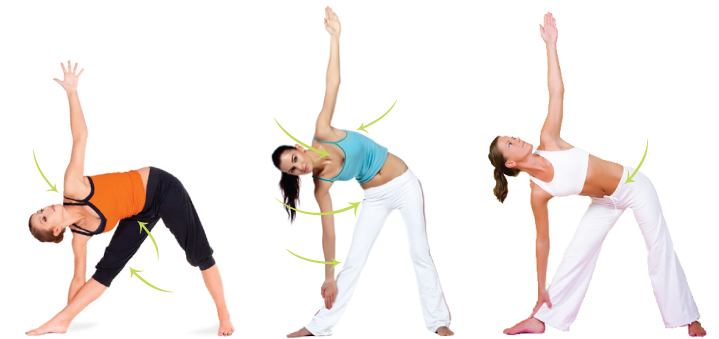
There is this interesting thing that I observed during my years of teaching yoga – it often seems that if the student has an incredible range in bending backward, she would probably have difficulty with pure side bending, while the folks who cannot bend back very far have a greater range in bending sideways. This is not the rule, of course – there is much variety in what our bodies can and cannot do, but it would make sense – the spine cannot be extra-mobile in every possible direction without compromising its stability.
We bend sideways to alternately stretch and contract the sides of the torso. To be able to accomplish that we need to keep the side bending “pure,” meaning keeping the body in one plane instead of folding into a familiar combination of the twist and forward bend. That way, we can get the benefits and minimize the risk to the sacrum (somewhat).
It is useful to explore the idea of pure side bending in the supine position, where you have a reference of the ground to show you which parts of the body tend to pop out of alignment. Let’s take a look at Jathara Parivrtti (lateral adaptation) or the Crescent Shape.
When we curve the body sideways like that, there will be a tendency of the opposite butt cheek to lift off the floor, so we need to make sure that we keep it down even if it means decreasing the curve of the body. The same dynamic will happen in the pure “pelvic opening” position (above). There will be a tendency to rotate the pelvis following the movement of the extended leg, and the upper body will try to do the same. The tighter the hips are, the more the pelvis will tip. To counteract that tendency, we can place the hand on the hip to help monitor its position; we can bend the extended leg to lessen the leverage, and we can limit the outer movement of the leg.
When we explore lateral bending in a standing position, it is best to begin with feet parallel to each other to concentrate the stretch on the side of the torso and keep the hip out of the equation. Here is how we do it.
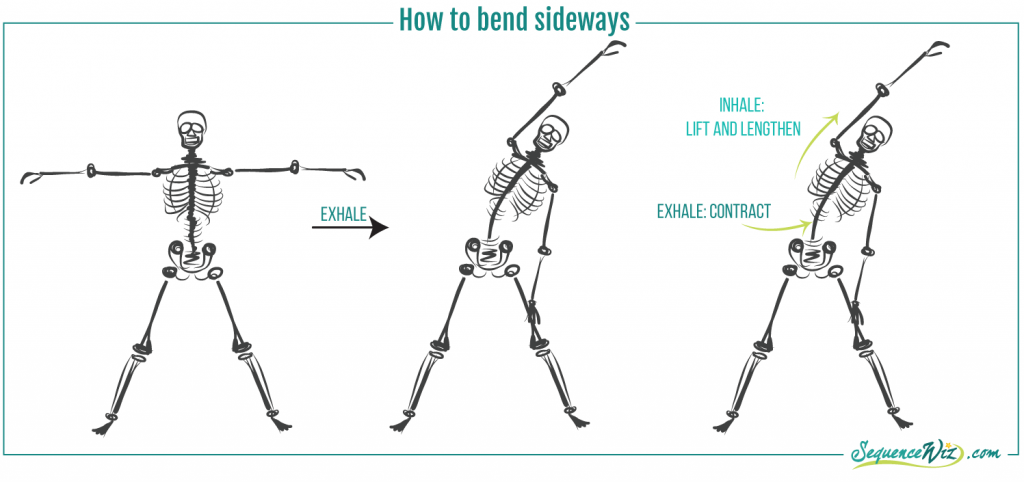 On the inhale, widen the chest and bring the arms out to the sides. On the exhale, gradually contract the abdomen and bend sideways, placing the bottom hand on the leg (try to keep the body in one plane). On the inhale, lengthen the spine, pull the chest away from the navel, and widen the collarbones. On the exhale, re-engage the abdomen, monitoring the position of the pelvis. Continue to breathe like that, making subtle adjustments to the position of the body as you breathe.
On the inhale, widen the chest and bring the arms out to the sides. On the exhale, gradually contract the abdomen and bend sideways, placing the bottom hand on the leg (try to keep the body in one plane). On the inhale, lengthen the spine, pull the chest away from the navel, and widen the collarbones. On the exhale, re-engage the abdomen, monitoring the position of the pelvis. Continue to breathe like that, making subtle adjustments to the position of the body as you breathe.
If you turn one foot out, you will add an additional challenge of monitoring the position of the pelvis in relation to your hip and increase the risk of tweaking your sacroiliac joint. Here are some other common release valves that often show up in lateral bends.
Troubleshooting
Most of those release valves show up because the student is striving to put the hand down on the floor or as far down the leg as possible. This is not necessary. The hand can land wherever it lands.
1. Exaggerating the spinal curve while in the pose can create tension in the lower back and strain the sacroiliac ligaments. This usually happens if the student has hypermobility in the lumbar spine. To prevent this from happening, we need to progressively contract the abdomen while moving into the pose (to control the tipping of the pelvis) and then continue to work with abdominal contraction on every exhalation while in the pose.
2. Excessive rounding of the upper back and displacing the chest forward usually happens if the student already has a pronounced upper back curve. To avoid excessive rounding we need to focus on widening the collarbones and pulling the chest away from the navel during inhalation. Turning the right leg further out will allow the head of the femur to slide deeper into the hip socket, which means that the pelvis will tip slightly to the right, allowing for a deeper side bend and less compression on the right side of the torso. Keeping the right knee slightly bent will help with that as well. If further hip rotation is not possible, the student needs to bring the hand higher up the leg and limit the range of the side bend.
3. Rotating the pelvis forward too much while bending sideways stresses the sacroiliac joint on the right side. We need to limit the pelvis displacement even if it means that the student won’t go as deep into the pose.
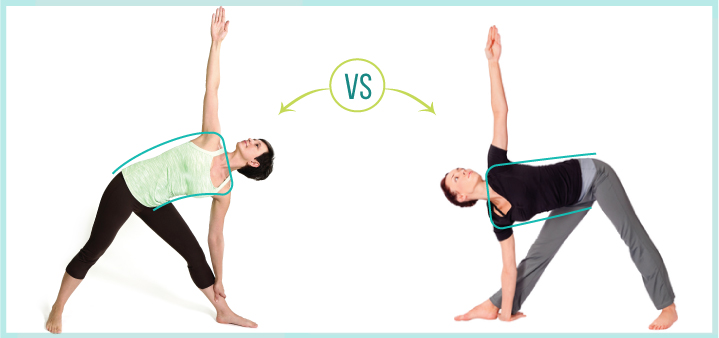
One of the most common ways of moving into Utthita Trikonasana is by thrusting the outer hip out and attempting to lengthen both sides of the body equally. This way of displacing the hip while moving into the pose might not be the best option for you.


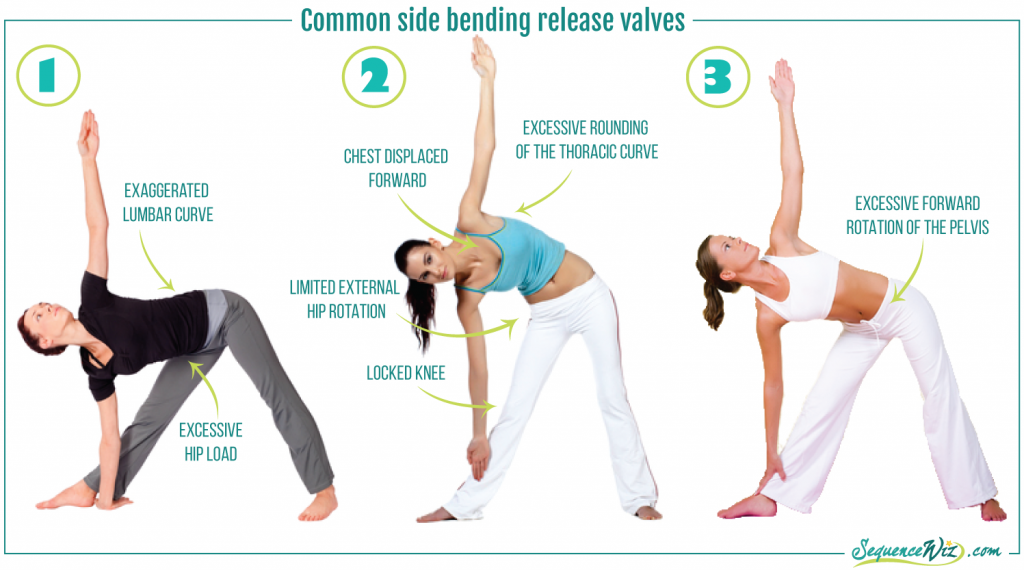

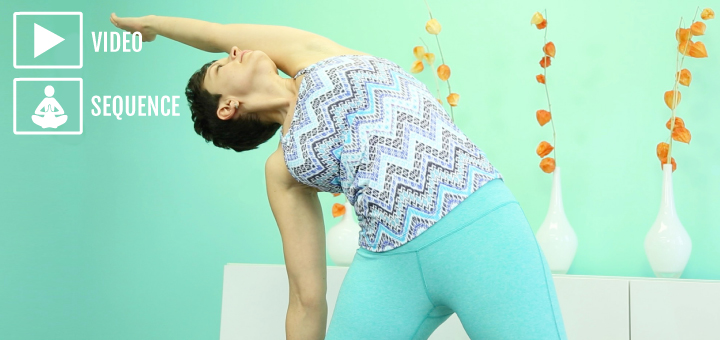
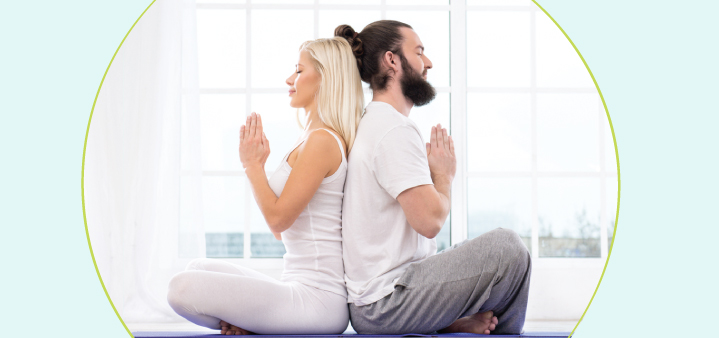






I love your diagrams & commentary. So clear and demonstrates wisdom in asana practice. Myth busters…. very useful for yoga teachers.
THANK YOU!
Thank you Sadani!
Olga,
I can’t tell you how many times I have struggled to trouble shoot people’s lateral bends. The release valve of rotating the pelvis is the one that always has me scratching my head, looking at the student and trying to tell them to move differently-then that student just never getting the message. In my teaching head I’m saying “What am I saying wrong??!” I have demonstrated these lateral bends-especially to my 50 Plus Yoga class continually and have subsequently hurt my back. I try and use a student to demo and I try really hard to describe with words how to go into a pose, but often I go back to me demonstrating! Not good yoga teachers-save your back! Teaching a population that is very limited in their movements-I find teaching the lateral bends really complicated at times! Thanks Olga your post is really helpful-I read your blog religiously.
Hi Kristen – I hear you! That’s why I like to initiate those exploration with super simple side bends (you can check my Instagram @ok.yoga for some ideas), and then keep the feet parallel in Trikonasana to really understand the dynamic of the side bending movement. I am glad to hear that you found the post useful!
I wonder what you think about this instruction on side bending by australiam master teacher:
I LOVE your concise instruction and diagrams. You have me over here re-thinking, re-feeling, and re-adjusting myself. Going into utthita trikonasana i am ALWAYS thrusting my hip. {And weekly I’ll have an SI problem that is only ever corrected after another class usually after using the strap.} And, of course, weekly, I try to re-play which class and which asana must have done it. I replay my form, my going in, my exiting and then loop like that until I’m exhausted trying to get to the source.
Please continue writing and sharing more about trikonasana, other side bends, and how to protect and care for our si. This is such a great difficulty of mine and finding your posts about them is really helping me to understand that what I’d learned is not necessarily good for my practice.
Hi,
Thank you. Please say more about the forward rotation of the pelvis as many years ago I was told by a Master teacher, due to my SI joint issue TO roll it forward a bit rather than the typical squaring it off.
Hi Ann! When you say “roll the pelvis forward” do you mean tip it forward so that it exaggerates the lumbar curve? In my tradition it is considered a “release valve”, I wrote a little bit about it here: http://sequencewiz.org/2015/08/19/common-pitfalls-while-bending-sideways/ (picture 3). Usually we put a lot of effort into controlling the forward tilt of the pelvis in any pose, since excessive tilt often leads to lower back strain and weaker core muscles. So, to answer your question, personally I would never recommend it in Triangle pose. Do you know the logic behind that recommendation from that teacher?
Hi,
No, picture 3 seems like an exaggerated forward roll. I was told to just let the hip naturally roll in just a bit rather than the strain of opening it up toward the ceiling. The exaggerated opening, like some old instruction of “between 2 panes of glass,” or “take a far reach forward” is what I believe contributed to my issue many years ago. I myself am a yoga therapist and have found when folks like myself with tight or inwardly rotated hips attempt to work against the body that I ended up through the years with SI joint dysfunction. Since I’ve practiced in that way I no longer experience that strain. Many years ago while in training with Judith Lasater I was experiencing this dysfunction. She assisted me in this different way and I’ve been practicing and teaching from it since. Can you post a picture of what you mean different from those 3 poses? I am curious as maybe it is the same. Perhaps it is harder to explain through the written word. Thank you.
Hi Ann – I think I know what you mean. I agree – it’s perfectly normal for the hip to turn forward a bit when you bend sideways. I think you can see that in the short video of me doing the pose at the end of this post: http://sequencewiz.org/2015/08/26/controversial-utthita-trikonasana-is-it-necessary-to-lengthen-both-sides-of-the-torso/ We just need to make sure that it doesn’t turn too much so that we don’t fall into the release valve that we’ve discussed earlier 🙂
I love this post! It was very helpful in my studies of Trikonasana.